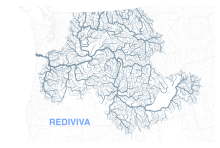About Columbia Rediviva
It is well known that the Columbia River takes its name from the boat captained by Robert Gray, who first sailed up the river in 1792. It is less appreciated that the full name of the eponymous ship was Columbia Rediviva, “Columbia Revived”. It is likely that Rediviva refers to a retrofit of the original Columbia, an upgrade requisite to it becoming the first U.S. ship to circumnavigate the globe.
Both because of its length and as proxy for the fabled Northwest Passage, the Columbia became gateway to the continent, the “River of the West”. As such, its name was bestowed on the surrounding region, a drainage area the size of France reaching from coastal temperate forests to the spine of the Canadian Rockies and down to inland deserts.
Columbia Rediviva is both trivia and symbol, past and prologue – suggesting a second version of our river, and our region, will be better equipped for the future.
Vision
Updating our 19th Century operating framework to align with our 21st Century understanding of two energy systems on the Columbia River - one electrical and one biological - will result in the largest river restoration project in U.S. history, a robust and distributed power grid, and a fundamental re-shaping of our relationship to the natural world.
The Challenge and The Opportunity – Salmon and Power
The Columbia River was once one of the world’s most productive salmon systems. Annual runs of 10–30 million fish, up to 50% of which originated in the Snake River and its tributaries, were defining events for all manner of life in the Pacific Northwest. Now, their absence shapes the region. Many Columbia River Basin salmon populations are already extinct; of those remaining, thirteen are endangered and over 80% are mass-produced in hatcheries instead of spawning naturally in the wild. These trends, despite decades of advocacy and billions of dollars committed to a sweeping portfolio of recovery efforts, testify that our current approach to managing salmon is fundamentally broken.
The Columbia is also the most hydroelectrically engineered river system on Earth – over 400 dams impound the Columbia and its tributaries. The Bonneville Power Administration (BPA) is an 80-year old, non-profit federal administration within the Department of Energy. The BPA markets power from 31 dams operated by the Army Corps of Engineers and the Bureau of Reclamation, and covers its costs through electricity sales and related services. In recent years, rising operation and maintenance costs, combined with the proliferation of cheaper renewables and lower demand for electricity from the dams, are exacerbating a regional surplus of power and impairing the BPA’s financial condition - requiring we reconsider the role of the Federal Columbia River Power System (FCRPS). Like salmon from their hatcheries, electrical energy wants out of command-and-control centralized bureaucracies and into systems where it can be diverse, creative, and distributed.
A combination of the unequivocal absence of progress towards salmon recovery and the urgent need to re-imagine our electrical grid offers an unprecedented opportunity to compare past promises, present realities, and future alternatives along the Columbia.
Our Work
Restoring self-sustaining populations of wild Columbia/Snake River salmon is one of the largest, practically achievable fisheries recovery projects on Earth. Ensuring a robust, clean, and distributed electrical grid is one of the most compelling social, economic, and environmental initiatives of our time.
Columbia Rediviva will curate a place-based conversation about the Columbia – its literal and figurative power structures, its salmon, its water, and its regional economy. An online and offline communications platform will explore our past, present, and future relationship to the river as both an economic and ecological system, reaching from continental shelf to continental divide. We will thoroughly expose the failure of a hatchery-based federal salmon recovery program - now the most expensive ecological recovery project in U.S. history - that equates industrial production with species protection. And we will highlight the potential for investment in a next-generation electrical grid that liberates streams large and small from service to inefficient, uncompetitive hydropower. We are writing, filming, and photographing; we are agitating and celebrating; we are speaking up at rate case hearings and budget committee meetings; and we are talking to groups large and small - on rivers, through media, in community halls.
Leadership
Columbia Rediviva is an intentional dis-organization, an advocacy to match the intended transformation for salmon and electricity - from centralized to distributed, from bureaucratic to creative. We are a coordinated network of citizen activists - energy experts and river guides, writers and filmmakers, biologists and farmers inspired by a vision of renewed abundance within the watershed. Join us!
